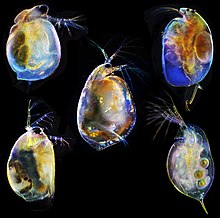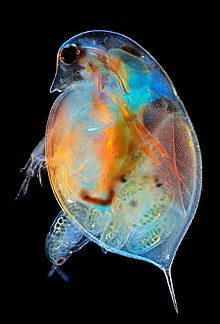Diplostraca
| Cladocera | |
|---|---|

| |
| Scientific classification | |
| Kingdom: | |
| Phylum: | |
| Subphylum: | |
| Class: | |
| Subclass: | |
| Order: | Cladocera Latreille, 1829
|
| Suborders | |
The Cladocera are an order of small crustaceans commonly called water fleas. Over 650 species have been recognised so far, with many more undescribed. They first appeared before the Permian period[1][2][3][4], and have since invaded most freshwater habitats. Some have also adapted to a life in the ocean, the only members of Branchiopoda to do so, even if several anostracans live in hypersaline lakes.[5] Most are 0.2–6.0 mm (0.01–0.24 in) long, with a down-turned head with a single median compound eye, and a carapace covering the apparently unsegmented thorax and abdomen. Most species show cyclical parthenogenesis, where asexual reproduction is occasionally supplemented by sexual reproduction, which produces resting eggs that allow the species to survive harsh conditions and disperse to distant habitats.
Description

They are mostly 0.2–6.0 mm (0.01–0.24 in) long, with the exception of Leptodora, which can be up to 18 mm (0.71 in) long.[6] The body is not obviously segmented and bears a folded carapace which covers the thorax and abdomen.[7]
The head is angled downwards, and may be separated from the rest of the body by a "cervical sinus" or notch.[7] It bears a single black compound eye, located on the animal's midline, in all but two genera, and often, a single ocellus is present.[8] The head also bears two pairs of antennae – the first antennae are small, unsegmented appendages, while the second antennae are large, segmented, and branched, with powerful muscles.[7] The first antennae bear olfactory setae, while the second are used for swimming by most species.[8] The pattern of setae on the second antennae is useful for identification.[7] The part of the head which projects in front of the first antennae is known as the rostrum or "beak".[7]
The mouthparts are small, and consist of an unpaired labrum, a pair of mandibles, a pair of maxillae, and an unpaired labium.[7] They are used to eat "organic detritus of all kinds" and bacteria.[7]
The thorax bears five or six pairs of lobed, leaf-like appendages, each with numerous hairs or setae.[7] Carbon dioxide is lost, and oxygen taken up, through the body surface.[7]
Lifecycle

With the exception of a few purely asexual species, the lifecycle of cladocerans is dominated by asexual reproduction, with occasional periods of sexual reproduction; this is known as cyclical parthenogenesis. The system evolved in the Permian, when the Cladocera arose.[9] When conditions are favourable, reproduction occurs by parthenogenesis for several generations, producing only female clones. As the conditions deteriorate, males are produced, and sexual reproduction occurs. This results in the production of long-lasting dormant eggs. These ephippial eggs can be transported over land by wind, and hatch when they reach favourable conditions, allowing many species to have very wide – even cosmopolitan – distributions.[7]
Ecology

Most cladoceran species live in fresh water and other inland water bodies, with only eight species being truly oceanic.[8] The marine species are all in the family Podonidae, except for the genus Penilia.[8] Some cladocerans inhabit leaf litter.[10]
Taxonomy

The order Cladocera is included in the class Branchiopoda, and forms a monophyletic group, which is currently divided into four suborders. Around 620 species have been described, but many more species remain undescribed.[6] The genus Daphnia alone contains around 150 species.[9]
These families are recognised:[11]
Order Cladocera Latreille, 1829
- Suborder Ctenopoda Sars, 1865
- Holopediidae Sars, 1865
- Sididae Baird, 1850
- Suborder Anomopoda Stebbing, 1902
- Bosminidae Baird, 1845
- Chydoridae Stebbing, 1902
- Daphniidae Straus, 1820
- Gondwanotrichidae Van Damme et al., 2007[12][13]
- Macrotrichidae Norman & Brady, 1867
- Suborder Onychopoda Sars, 1865
- Cercopagididae Mordukhai-Boltovskoi, 1968
- Podonidae Mordukhai-Boltovskoi, 1968
- Polyphemidae Baird, 1845
- Suborder Haplopoda Sars, 1865
- Leptodoridae Lilljeborg, 1900
Etymology
The word "Cladocera" derives via New Latin from the Ancient Greek κλάδος (kládos, "branch") and κέρας (kéras, "horn").[14]
See also
- Bythotrephes longimanus (invasive species) [formerly known as Bythotrephes cederstroemi[15]] - Spiny Water Flea[16]
- Cercopagis pengoi (invasive species)
- Daphnia lumholtzi (invasive species)
- Moina (smallest)
- Zooplankton
References
- ^ Kotov, Alexey (2007). "Jurassic Cladocera (Crustacea, Branchiopoda) with a description of an extinct Mesozoic order". Journal of Natural History. 41: 13--37. doi:10.1080/00222930601164445.
- ^ Kotov, Alexey (2009). "New finding of Mesozoic ephippia of the Anomopoda (Crustacea: Cladocera)". Journal of Natural History. 43: 523--528. doi:10.1080/00222930802003020.
- ^ Kotov, Alexey; Korovchinsky, Nikolai (2006). "First record of fossil Mesozoic Ctenopoda (Crustacea, Cladocera)". Zoological Journal of the Linnean Society. 146 (2): 269--274. doi:10.1111/j.1096-3642.2006.00204.x.
- ^ Kotov, Alexey; Taylor, Derek (2011). "Mesozoic fossils (>145 Mya) suggest the antiquity of the subgenera of Daphnia and their coevolution with chaoborid predators". BMC Evolutionary Biology. 11: 129. doi:10.1186/1471-2148-11-129.
- ^ Vernberg, F. John (2014). Environmental Adaptations. Elsevier Science. pp. 338–. ISBN 978-0-323-16282-1.
- ^ a b L. Forró; N. M. Korovchinsky; A. A. Kotov; A. Petrusek (2008). "Global diversity of cladocerans (Cladocera; Crustacea) in freshwater" (PDF). Hydrobiologia. 595 (1): 177–184. doi:10.1007/s10750-007-9013-5. doi:10.1007/978-1-4020-8259-7_19
- ^ a b c d e f g h i j Douglas Grant Smith; Kirstern Work (2001). "Cladoceran Branchiopoda (water fleas)". In Douglas Grant Smith (ed.). Pennak's Freshwater Invertebrates of the United States: Porifera to Crustacea (4th ed.). John Wiley and Sons. pp. 453–488. ISBN 978-0-471-35837-4.
- ^ a b c d Denton Belk (2007). "Branchiopoda". In Sol Felty Light; James T. Carlton (eds.). The Light and Smith Manual: Intertidal Invertebrates from Central California to Oregon (4th ed.). University of California Press. pp. 414–417. ISBN 978-0-520-23939-5.
- ^ a b Ellen Decaestecker; Luc De Meester; Joachim Mergaey (2009). "Cyclical parthenogeness in Daphnia: sexual versus asexual reproduction". In Isa Schön; Koen Martens; Peter van Dijk (eds.). Lost Sex: The Evolutionary Biology of Parthenogenesis. Springer. pp. 295–316. doi:10.1007/978-90-481-2770-2_15. ISBN 978-90-481-2769-6.
- ^ Rubbo, Michael J.; Kiesecker, Joseph M. (2004). "Leaf litter composition and community structure: translating regional species changes into local dynamics". Ecology. 85 (9): 2519–2525. doi:10.1890/03-0653.
- ^ Joel W. Martin; George E. Davis (2001). An Updated Classification of the Recent Crustacea (PDF). Natural History Museum of Los Angeles County. pp. 1–132.
- ^ K. Van Damme; R. J. Shiel; H. J. Dumont (2007). "Notothrix halsei gen. n., sp. n., representative of a new family of freshwater cladocerans (Branchiopoda, Anomopoda) from SW Australia, with a discussion of ancestral traits and a preliminary molecular phylogeny of the order". Zoologica Scripta. 36 (5): 465–487. doi:10.1111/j.1463-6409.2007.00292.x.
- ^ K. Van Damme; R. J. Shiel; H. J. Dumont (2007). "Gondwanotrichidae nom. nov. pro Nototrichidae Van Damme, Shiel & Dumont, 2007". Zoologica Scripta. 36 (5): 623. doi:10.1111/j.1463-6409.2007.00304.x.
- ^ "Cladoceran". Webster's II New College Dictionary (3rd ed.). Houghton Mifflin Harcourt. 2005. p. 211. ISBN 978-0-618-39601-6.
- ^ USGS Nonindigenous Aquatic Species: Bythotrephes longimanus
- ^ (April 16, 2013) NorthAmericanFishing - "Silent Invaders" Spiny Water Flea PT 1 2013
External links
- Cladocera – Guide to the Marine Zooplankton of South Eastern Australia
 Media related to Diplostraca at Wikimedia Commons
Media related to Diplostraca at Wikimedia Commons Data related to Diplostraca at Wikispecies
Data related to Diplostraca at Wikispecies

